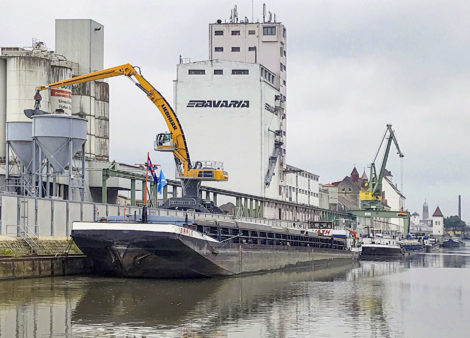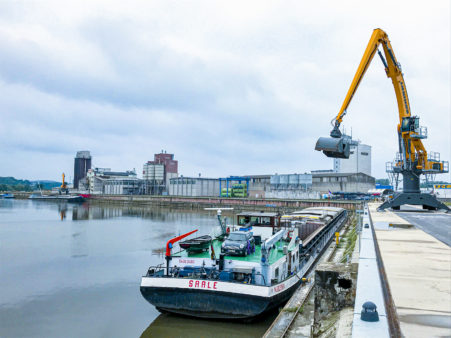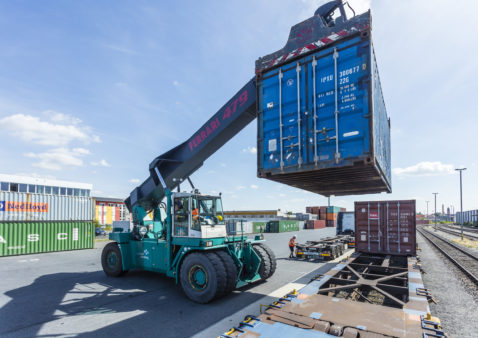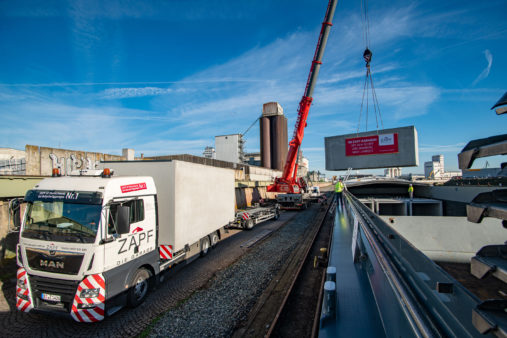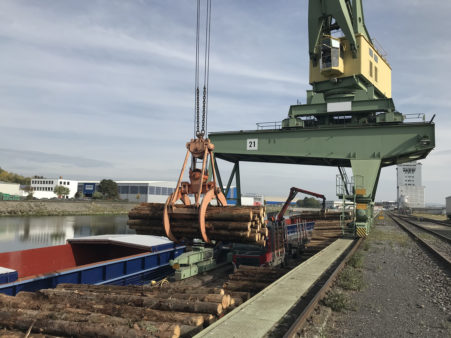12 March 2021 | Bamberg
Despite year of crisis, bayernhafen Bamberg holds its ground
2020 financial year: 467,060 tonnes of goods moved by inland waterway and rail; bayernhafen invests around €700,000
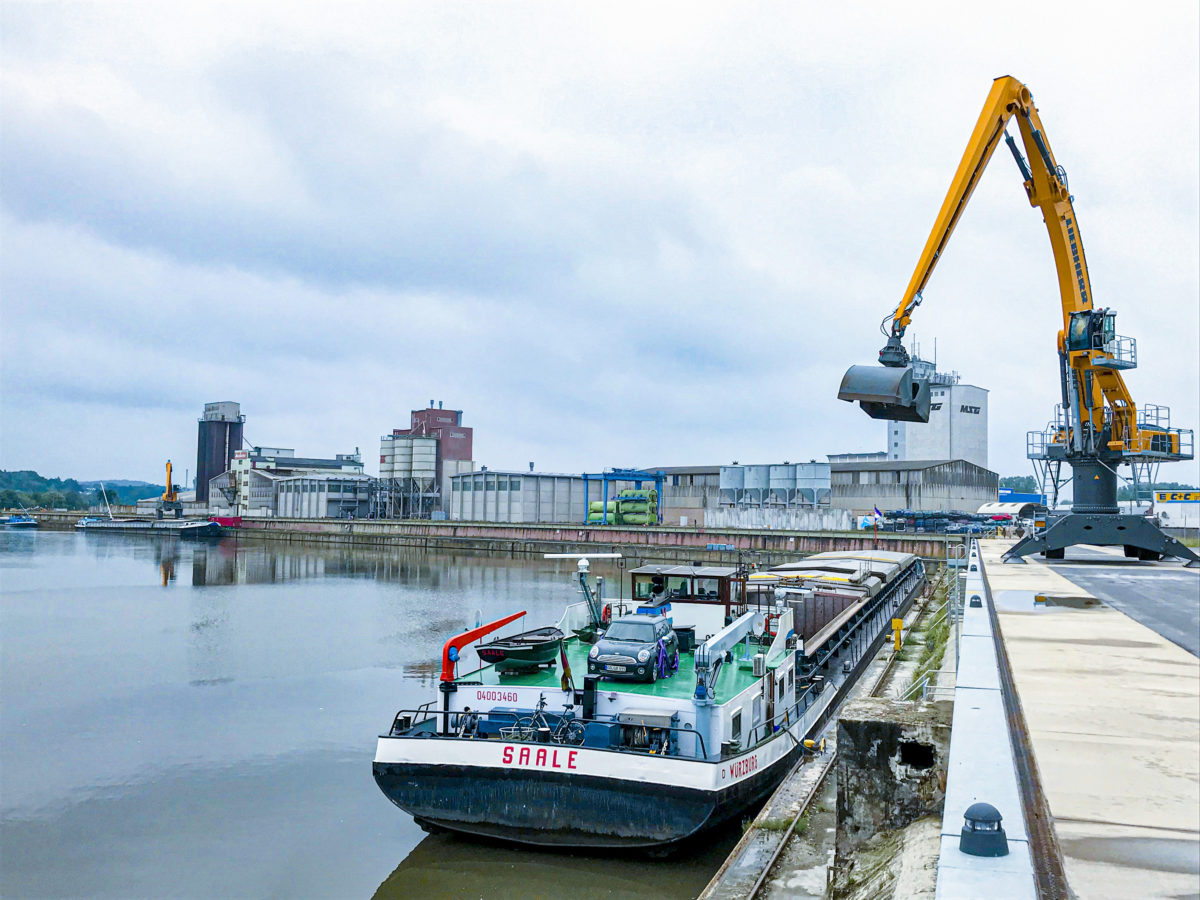
The lion’s share of the shipping tonnage was made up of animal feed, agricultural and forestry produce, and minerals and earths.
Bamberg, 12 March 2021 – bayernhafen Bamberg brings together a highly diverse range of goods and shifts long-distance traffic from the road networks to the two environmentally friendly transport modes of inland waterway and rail. Even – and indeed, particularly so – in times of crisis, we must be able to rely on the steady supply of the goods that meet our daily needs and that companies in Bavaria can continue to deliver their products to their customers. In the 2020 financial year bayernhafen Bamberg moved 467,060 tonnes of goods by inland waterway and rail – almost 80% of the volume achieved in the previous year. This corresponds to around 27,000 fewer truck journeys per year.
In 2020, inland waterway handling in bayernhafen Bamberg remained practically at the same level as the previous year: the 237,187 tonnes moved in 2020 represents a slight fall of 1.35% on the 240,422 tonnes moved in the 2019 financial year.
The lion’s share of the shipping tonnage was made up of animal feed, agricultural and forestry produce, and minerals and earths. Rail freight handling in bayernhafen Bamberg fell by a third in 2020, dropping by 114,851 tonnes to 229,873 tonnes. This was principally the result of the sharp reduction in the production of mineral oil. Rail freight handling primarily involved scrap iron and steel.
It is absolutely essential for our society that goods reach their destination. Even – and indeed, particularly so – in such trying times, port operations held steady, and the companies operating from bayernhafen Bamberg ensured that the supply chains that deliver the goods that meet our daily needs worked efficiently.”
Anja Bokeloh
Head of Technology and Operations
“It is absolutely essential for our society that goods reach their destination,” says Anja Bokeloh, Head of Technology and Operations at bayernhafen Bamberg. “Even – and indeed, particularly so – in such trying times, port operations held steady, and the companies operating from bayernhafen Bamberg ensured that the supply chains that deliver the goods that meet our daily needs worked efficiently.”
Bamberg, along with Aschaffenburg , Nuremberg and Roth, Regensburg and Passau, is one of the six bayernhafen locations. Even in times of crisis, through its skill in developing interfaces, bayernhafen continues to achieve its goal of furthering the modal shift, because the ability of the bayernhafen locations to efficiently link the different transport modes enables businesses to opt for rail and inland waterway as alternatives to long-distance transport by road. Through this strategy, bayernhafen is making a key contribution to tapping the full potential of the different transport modes. This takes pressure off the road networks and reduces CO2 emissions.
Combined Transport achieves 93% of the freight handled in the previous year
Combined transport involves linking at least two modes of transport, with intermodal trains generally being used for long-distance transport (the so-called ‘main leg’) and trucks used for delivery to the container terminal (preliminary/initial leg) and to the end customers (last mile/final leg). In the process, the transport medium remains the same: in combined transport, containers, swap bodies and semi-trailers are deployed. Containers are used for importing intermediate products, components and commercial goods as well as for exporting regional products. Containers are THE symbol of global trade that connect Bavaria to Asia, North and South America, and the entire world.
In 2020, despite the pandemic, the container terminal in bayernhafen Bamberg achieved 93% of the volume it handled in 2019, with a total of 29,797 TEU (twenty-foot equivalent unit) handled by rail and road, and vice versa.
Port infrastructure optimised
In 2020, bayernhafen once again maintained the high level of investment it had made over the previous years, investing around €700,000 in bayernhafen Bamberg’s port infrastructure, such as in maintenance work on its rail infrastructure. In 2021, bayernhafen Bamberg will develop quay 3 to handle heavy-lift freight and also install shore-side electricity supply facilities for cruise ships.
New companies in bayernhafen Bamberg
Companies are also investing in their corporate sites in bayernhafen Bamberg: Biosyntec GmbH is currently carrying out preparatory work in bayernhafen Bamberg on its biodiesel and hydrogenated vegetable oil (HVO) trading and storage facilities.
High & heavy freight handled in bayernhafen Bamberg
In addition to machinery, timber and steel components for wind turbines, bayernhafen Bamberg was once again the venue for the loading of garages manufactured by ZAPF GmbH on to barge: this time, it involved the transport of eighty-six 13-14 tonne prefabricated garages from Bayreuth to bayernhafen Bamberg by truck in the middle of November. The garages were loaded onto barge in bayernhafen Bamberg by Merkel Autokrane GmbH. The garages then “swam” for seven days down the Main-Danube canal, Main and Rhine to their destination of Utrecht in the Netherlands.
In its capacity as ‘site architect’ bayernhafen creates the conditions for providing high-intensity logistics companies with commercial sites in close proximity to rail and inland waterway facilities.”
Alexander Zeiger
Head of Real Estate Business, bayernhafen Bamberg
“In its capacity as ‘site architect’ bayernhafen creates the conditions for providing high-intensity logistics companies with commercial sites in close proximity to rail and inland waterway facilities,” says Alexander Zeiger, Head of Real Estate Business at bayernhafen Bamberg. “We pool goods for our customers and, as a regional hub, make it possible for them to benefit from the more environmentally friendly transport modes of inland waterway and rail. One of our key focuses is the protection of biodiversity – for example, we use goats and sheep as animal lawnmowers to keep our grassland areas in shape.”
Cruise ship pier used only very little in 2020
As a result of the restrictions placed on tourism, only 64 cruise ships docked at bayernhafen Bamberg in 2020. It is to be assumed that 2021 will also see a significantly lower ‘white fleet’ volume in comparison with previous years (2019: 831 cruise ships). “As soon as everything starts again, our piers and our new bus park will be ready and waiting,” says Alexander Zeiger. “In the meantime, we will use the time in 2021 to expand our shore-side electricity supply facilities.”

